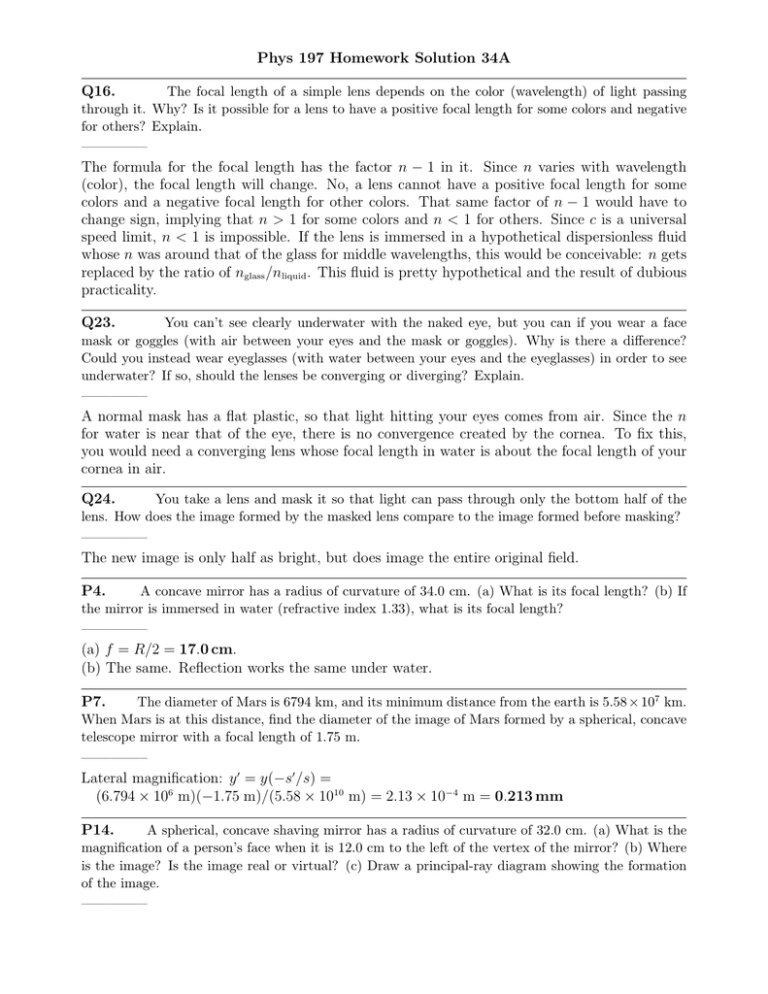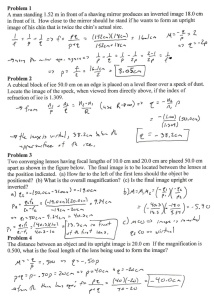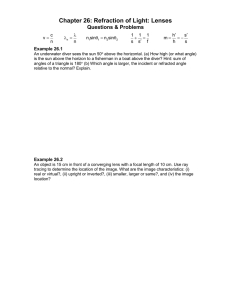Phys 197 Homework Solution 34A Q16.
advertisement

Phys 197 Homework Solution 34A Q16. The focal length of a simple lens depends on the color (wavelength) of light passing through it. Why? Is it possible for a lens to have a positive focal length for some colors and negative for others? Explain. ————– The formula for the focal length has the factor n − 1 in it. Since n varies with wavelength (color), the focal length will change. No, a lens cannot have a positive focal length for some colors and a negative focal length for other colors. That same factor of n − 1 would have to change sign, implying that n > 1 for some colors and n < 1 for others. Since c is a universal speed limit, n < 1 is impossible. If the lens is immersed in a hypothetical dispersionless fluid whose n was around that of the glass for middle wavelengths, this would be conceivable: n gets replaced by the ratio of nglass /nliquid . This fluid is pretty hypothetical and the result of dubious practicality. Q23. You can’t see clearly underwater with the naked eye, but you can if you wear a face mask or goggles (with air between your eyes and the mask or goggles). Why is there a difference? Could you instead wear eyeglasses (with water between your eyes and the eyeglasses) in order to see underwater? If so, should the lenses be converging or diverging? Explain. ————– A normal mask has a flat plastic, so that light hitting your eyes comes from air. Since the n for water is near that of the eye, there is no convergence created by the cornea. To fix this, you would need a converging lens whose focal length in water is about the focal length of your cornea in air. Q24. You take a lens and mask it so that light can pass through only the bottom half of the lens. How does the image formed by the masked lens compare to the image formed before masking? ————– The new image is only half as bright, but does image the entire original field. P4. A concave mirror has a radius of curvature of 34.0 cm. (a) What is its focal length? (b) If the mirror is immersed in water (refractive index 1.33), what is its focal length? ————– (a) f = R/2 = 17.0 cm. (b) The same. Reflection works the same under water. The diameter of Mars is 6794 km, and its minimum distance from the earth is 5.58 × 107 km. When Mars is at this distance, find the diameter of the image of Mars formed by a spherical, concave telescope mirror with a focal length of 1.75 m. P7. ————– Lateral magnification: y ′ = y(−s′ /s) = (6.794 × 106 m)(−1.75 m)/(5.58 × 1010 m) = 2.13 × 10−4 m = 0.213 mm P14. A spherical, concave shaving mirror has a radius of curvature of 32.0 cm. (a) What is the magnification of a person’s face when it is 12.0 cm to the left of the vertex of the mirror? (b) Where is the image? Is the image real or virtual? (c) Draw a principal-ray diagram showing the formation of the image. ————– We have that f = R/2 = +16 cm. From Eq 34-16, we have that (using cm): s′ = f s/(s−f ) = (+16)(+12)/(12−16) = −48 cm. This means it’s 48 cm behind the mirror. (a) m = −s′ /s = −(−48)/12 = +4.0. (b) As calculated above, the image is 48 cm behind the mirror. This is a virtual image. (c) on request. P29. A converging lens forms an image of an 8.00-mm-tall real object. The image is 12.0 cm to the left of the lens, 3.40 cm tall, and erect. What is the focal length of the lens? Where is the object located? ————– Get the location first. Since the image is to the left of the lens, it is virtual, and s′ is negative. From m = −s′ /s, we have s = −s′ /m = −(−12 cm)/(3.4 cm/0.8 cm) = +2.82 cm. f = ss′ /(s + s′ ) = (+2.82)(−12)/(−12 + 2.82) = +3.69 cm s = 2.82 cm, as shown above. P54. Contact Lenses. Contact lenses are placed right on the eyeball, so the distance from the eye to an object (or image) is the same as the distance from the lens to that object (or image). A certain person can see distant objects well, but his near point is 45.0 cm from his eyes instead of the usual 25.0 cm. (a) Is this person nearsighted or farsighted? (b) What type of lens (converging or diverging) is needed to correct his vision? (c) If the correcting lenses will be contact lenses, what focal length lens is needed and what is its power in diopters? ————– (a) Farsighted. (b) Converging. (c) f = ss′ /(s + s′ ) = (25)(−45)/(25 − 45) = +56.25 cm Diopters is the inverse of f in meters = 1/f = 1/0.5625 m = 1.78 diop P55. Ordinary Glasses. Ordinary glasses are worn in front of the eye and usually 2.0 cm in front of the eyeball. Suppose that the person in Problem 34.54 prefers ordinary glasses to contact lenses. What focal length lenses are needed to correct his vision, and what is their power in diopters? ————– As before, the object should be 25 cm in front of the eye, and the image 45 cm from the eye. Allowing for the 2-cm offset between the eye and the lens, s′ = −43 cm and s = 23 cm. f = ss′ /(s + s′ ) = (23)(−43)/(23 − 43) = 49.5 cm; 2.02 diop. P65. A telescope is constructed from two lenses with focal lengths of 95.0 cm and 15.0 cm, the 95.0-cm lens being used as the objective. Both the object being viewed and the final image are at infinity. (a) Find the angular magnification for the telescope. (b) Find the height of the image formed by the objective of a building 60.0 m tall, 3.00 km away. (c) What is the angular size of the final image as viewed by an eye very close to the eyepiece? ————– (a) Mtel = −f1 /f2 = −95/15 = −6.33. (per eq. 34.25) (b) m = −s′ /s = −(0.95 m)/(3000 m) = 3.17 × 10−4 ⇒ y ′ = my = −0.19 m = −1.90 cm. (c) θ′ = M θ = (6.333)(60/3000) = 0.127 rad




